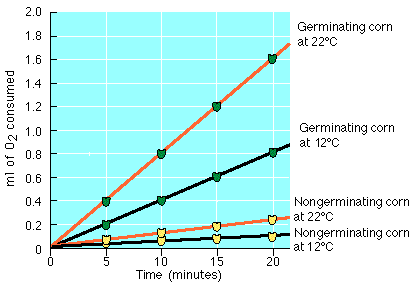Instructions for Side by Side Printing
- Print the notecards
- Fold each page in half along the solid vertical line
- Cut out the notecards by cutting along each horizontal dotted line
- Optional: Glue, tape or staple the ends of each notecard together
Lab Chapter 7: Cellular Respiration Quiz
front 1 Which of the following molecules is NOT a product of cellular respiration? | back 1 glucose |
front 2 Name TWO processes in plants that require ATP? | back 2 There are countless processes in plants that require ATP. A few examples are the building of starch from glucose, active transport of ions across the membranes of cells, and production of sugars in the Calvin cycle of photosynthesis. |
front 3 In your virtual experiment, to determine the rate of cellular respiration the amount of carbon dioxide produced was measured. | back 3 False |
front 4 In the respirometer example using the cricket, what happens to the CO2 produced by the cricket? | back 4 The CO2 produced by the cricket during respiration combines with KOH to form solid precipitate K2CO3, as the O2 is used and the pressure of gases inside the respirator decreases, causing the water to enter the pipette. The gas volume inside the vial decreases, the pressure of water outside the vial forces water into the pipette. The amount of water that enters the pipette is directly proportional to the amount of oxygen consumed by the cricket, measuring the water volume in the pipette gives the measure of the rate of respiration. |
front 5 When reading the water level in a pipette what is the appropriate location of the meniscus to take the reading? | back 5 bottom of the curve |
front 6 List the 7 steps for setting up the respirometers in the pea experiment. (make sure to label each step) | back 6 1) In each of the 3 vials, soak absorbant cotton with KOH solution, 2) Cover the solution with a dry non-absorbant cotton, 3) In vial #1, add germinating peas, 4) In vial #2, add non-germinating peas and glass beads to same level as vial #1, 5) In vial #3 (control), add glass beads to same level as vials #1 & #2, 6) Cap each vial with a stopper fitted with a pipette tip pointed outward, and 7) Add a weight to each vial. |
front 7 How do you correct for differences in volume that are due to temperature fluctuation rather than rate of respiration? | back 7 Gas volume is related to the temperature of the gas. According to the gas law (V=nRT/P) , a change in temperature will cause a direct change in volume. As the temperature in the respirometers may vary during the course of the experiment, correct for differences in volume that are due to temperature fluctuation rather than rate of respiration. To do this, subtract any difference in the movement of water into the vial with glass beads from the experimental vials held at the same temperature, then record the result as the corrected difference. |
front 8 Calculate the rate of oxygen consumption based on the respirometer readings below: Initial water level - .05 ml Water level at 10 minutes - .26 ml | back 8 .021 ml/min |
front 9  Which of the following is a true statement based on the data? | back 9 The amount of oxygen consumed by germinating corn at 22°C is approximately twice the amount of oxygen consumed by germinating corn at 12°C. Study the graph carefully to see that at 10 minutes the 22°C germinating corn consumed 0.8ml of oxygen, while the 12°C germinating corn consumed 0.04 ml of oxygen. |
front 10 What is the role of KOH in this experiment? | back 10 ✔ d.It binds with carbon dioxide to form a solid, preventing CO2 production from affecting gas volume. As carbon dioxide is released, it is removed from the air in the vial by this precipitation. Since oxygen is being consumed during cellular respiration, the total gas volume in the vial decreases. This causes pressure to decrease inside the vial, and water begins to enter the pipette. |
front 11 What is the rate of oxygen consumption in germinating corn at 12°C? | back 11 ✔ b. 0.04 ml/min To calculate this, it is easiest to find the change in y at 10 minutes (0.4 ml − 0 ml = 0.4) and divided by the change in x (10 minutes − 0 minutes = 10 minutes). 0.4 ml/10 minutes = 0.04 ml/min. |
front 12 Which of the following conclusions is supported by the data? | back 12 The rate of respiration increases as the temperature increases in both germinating and nongerminating seeds. |